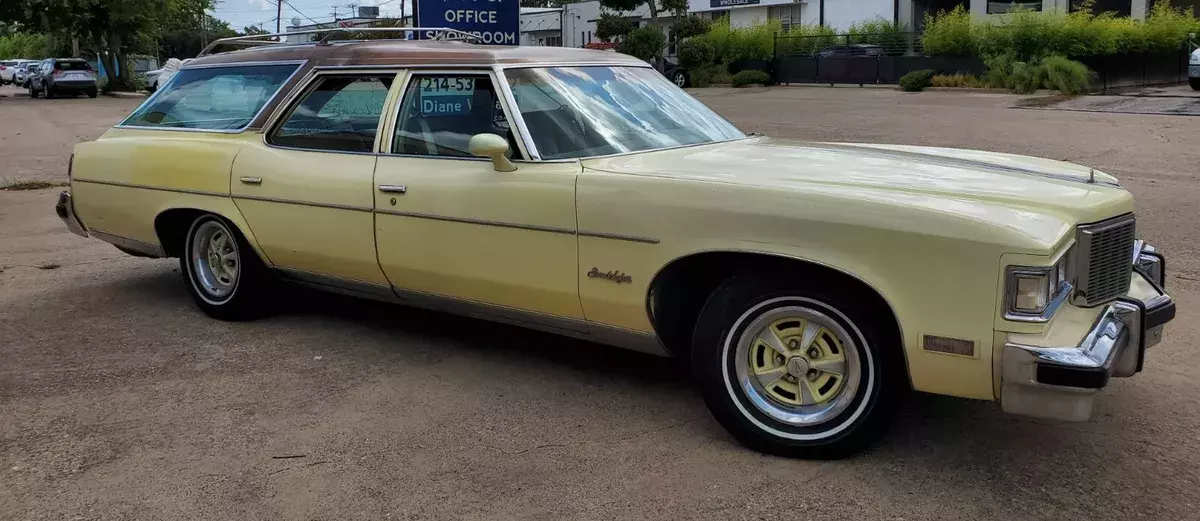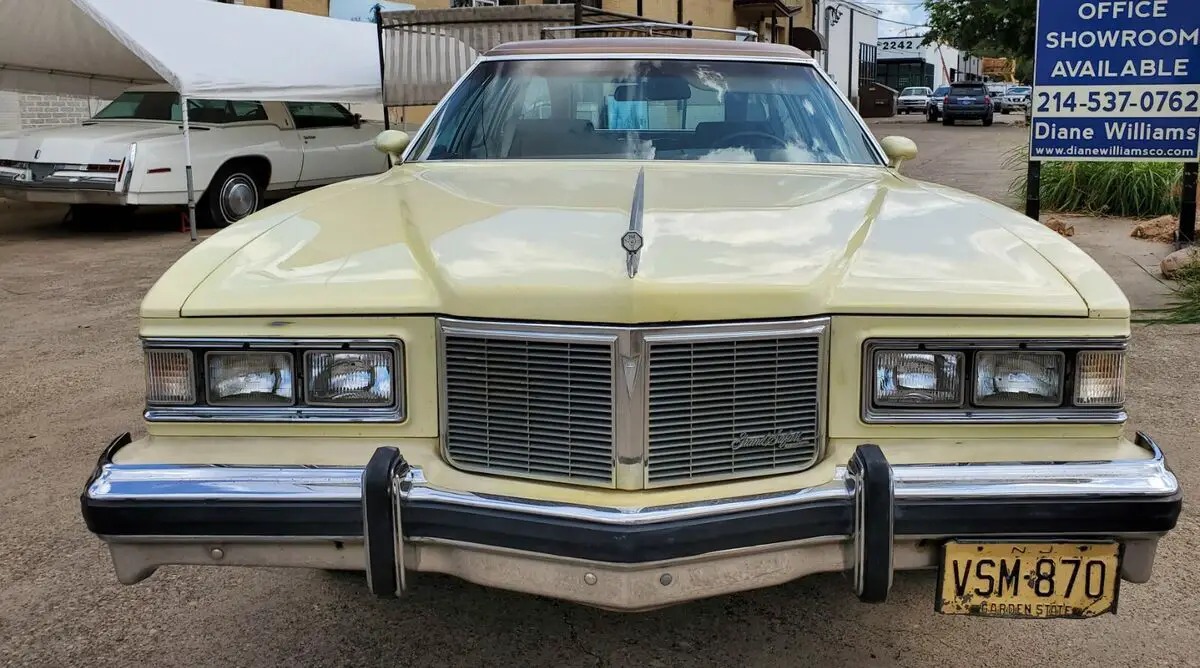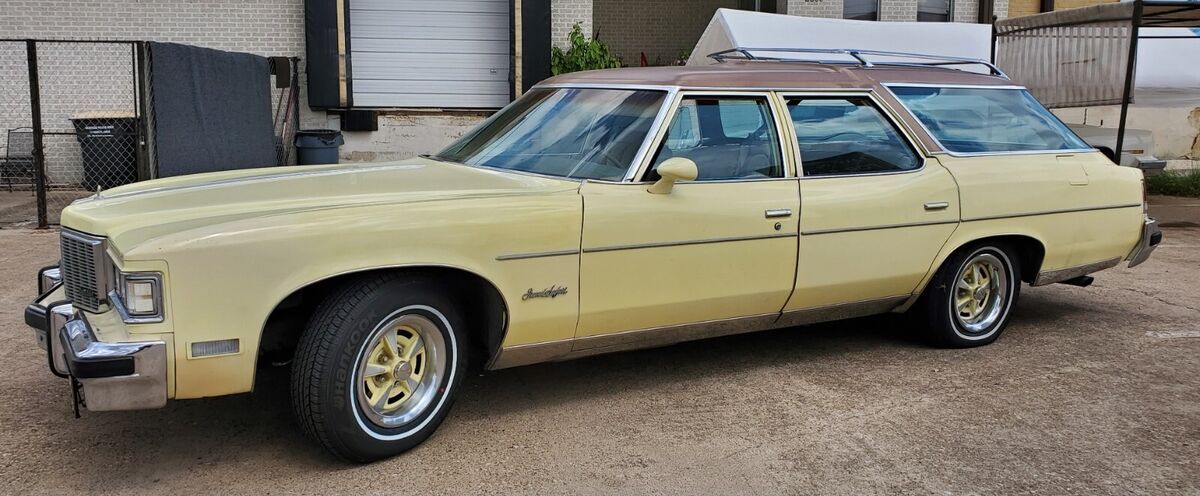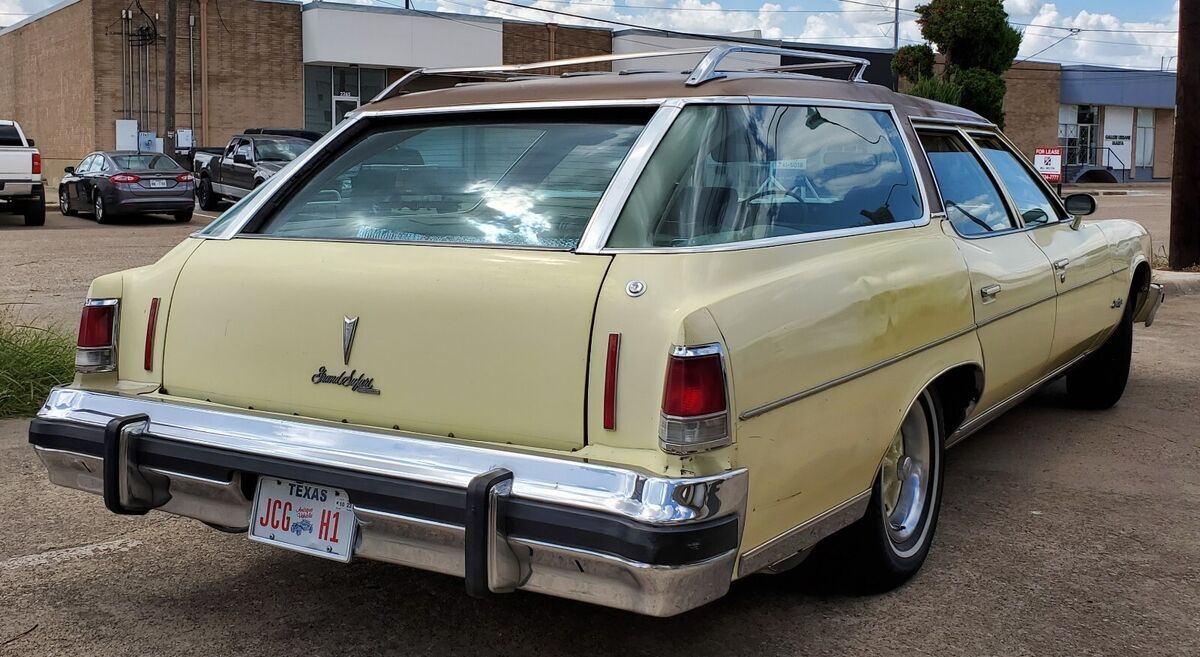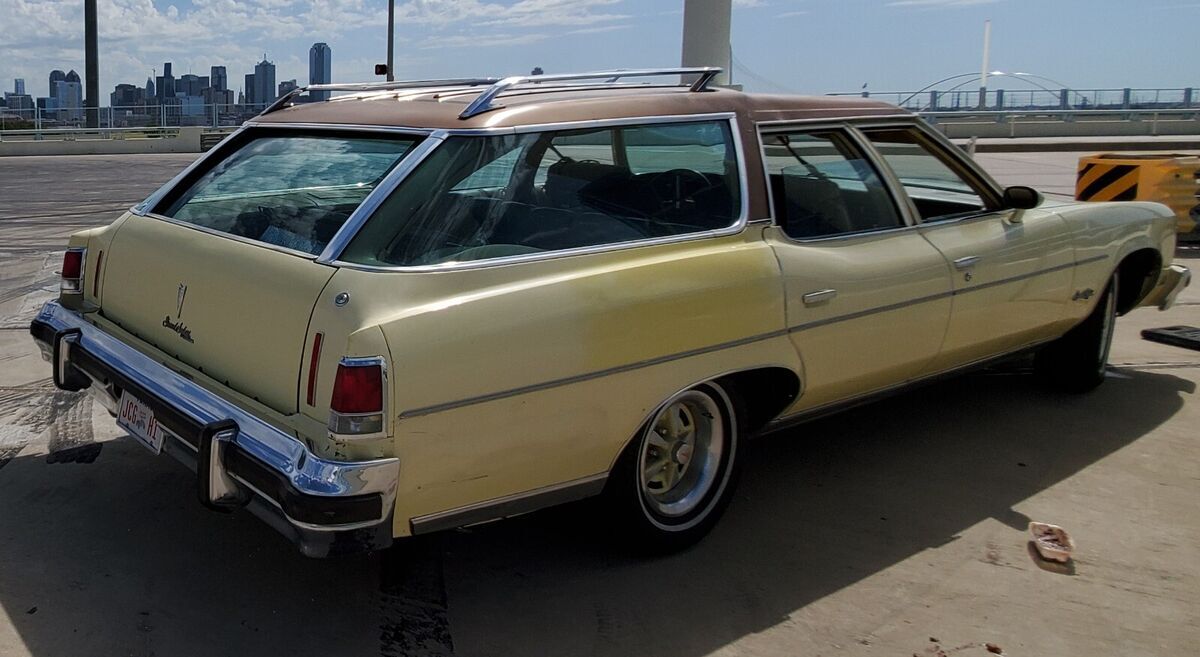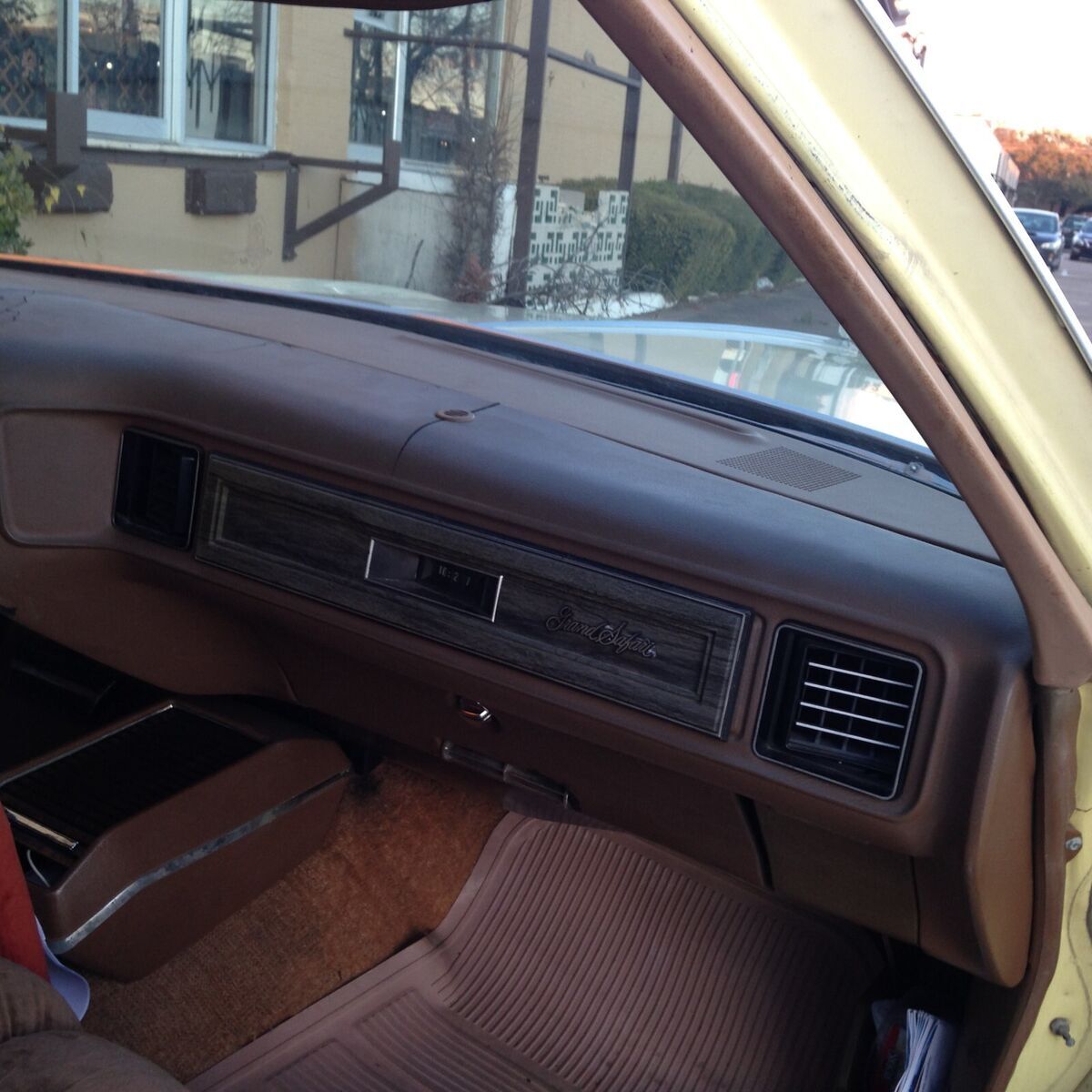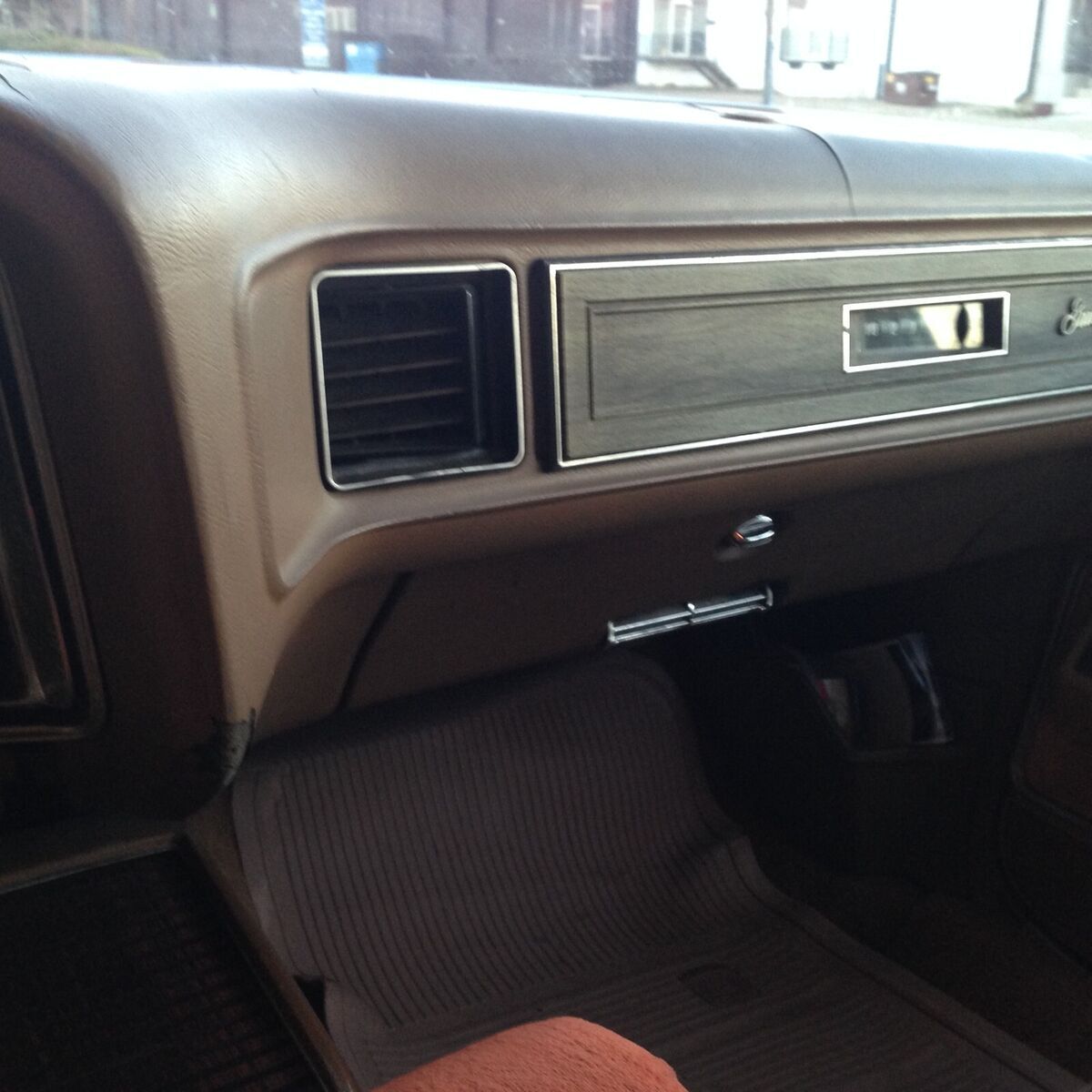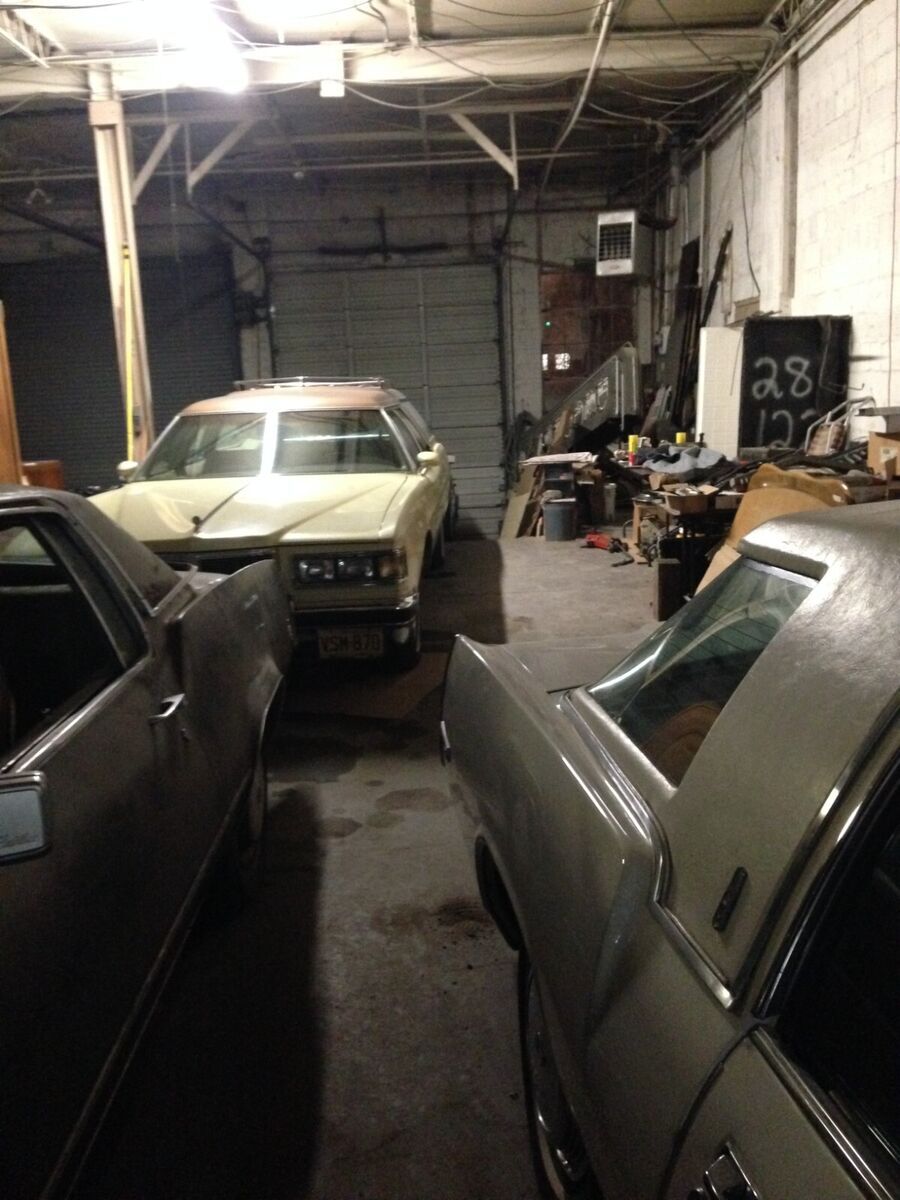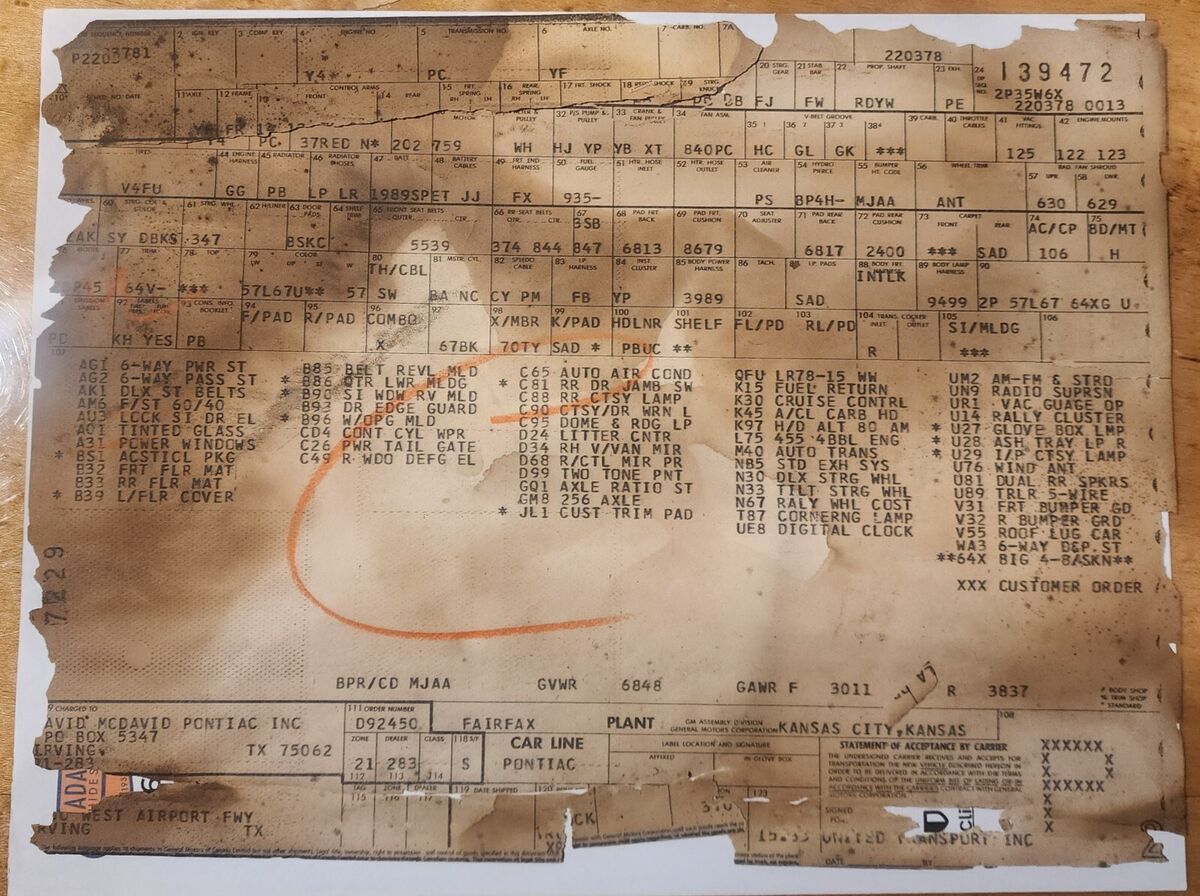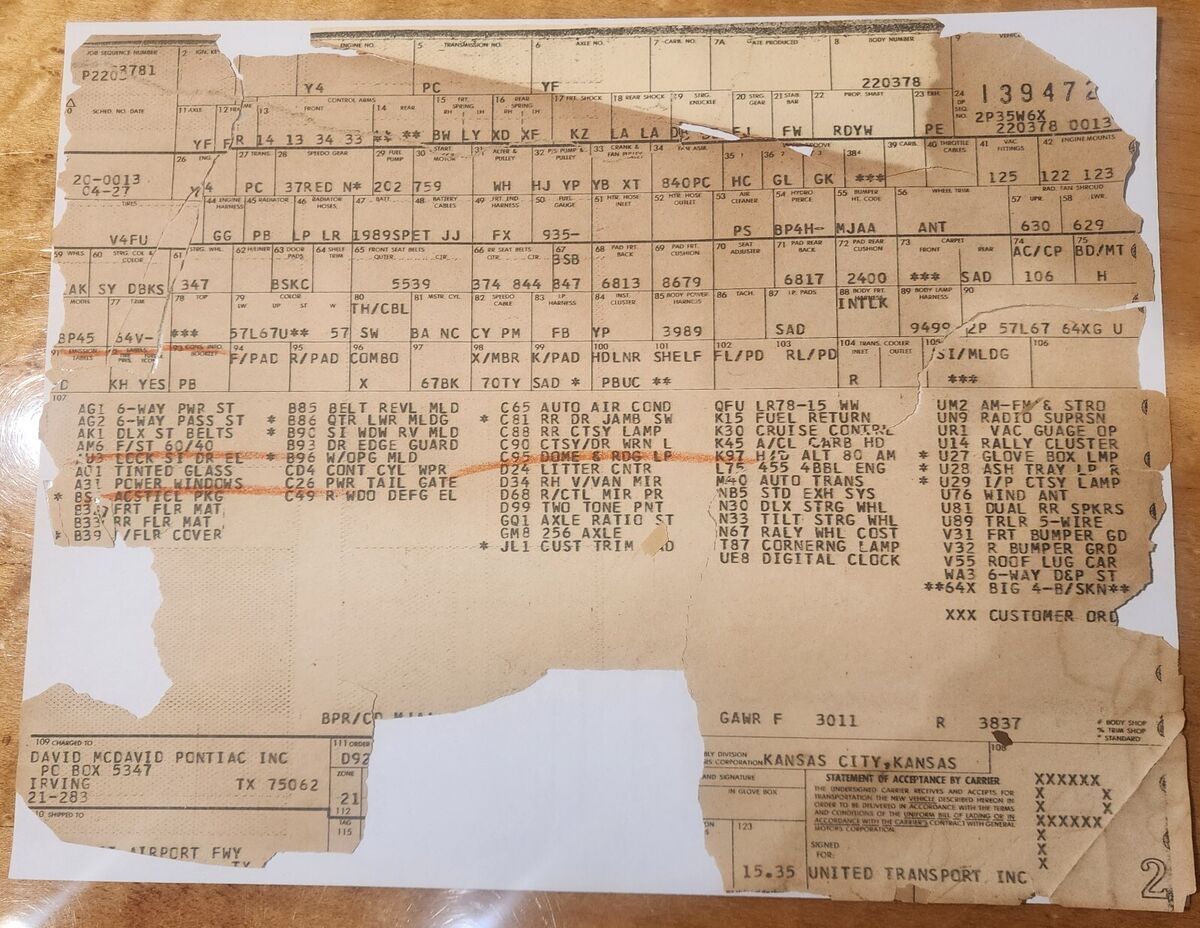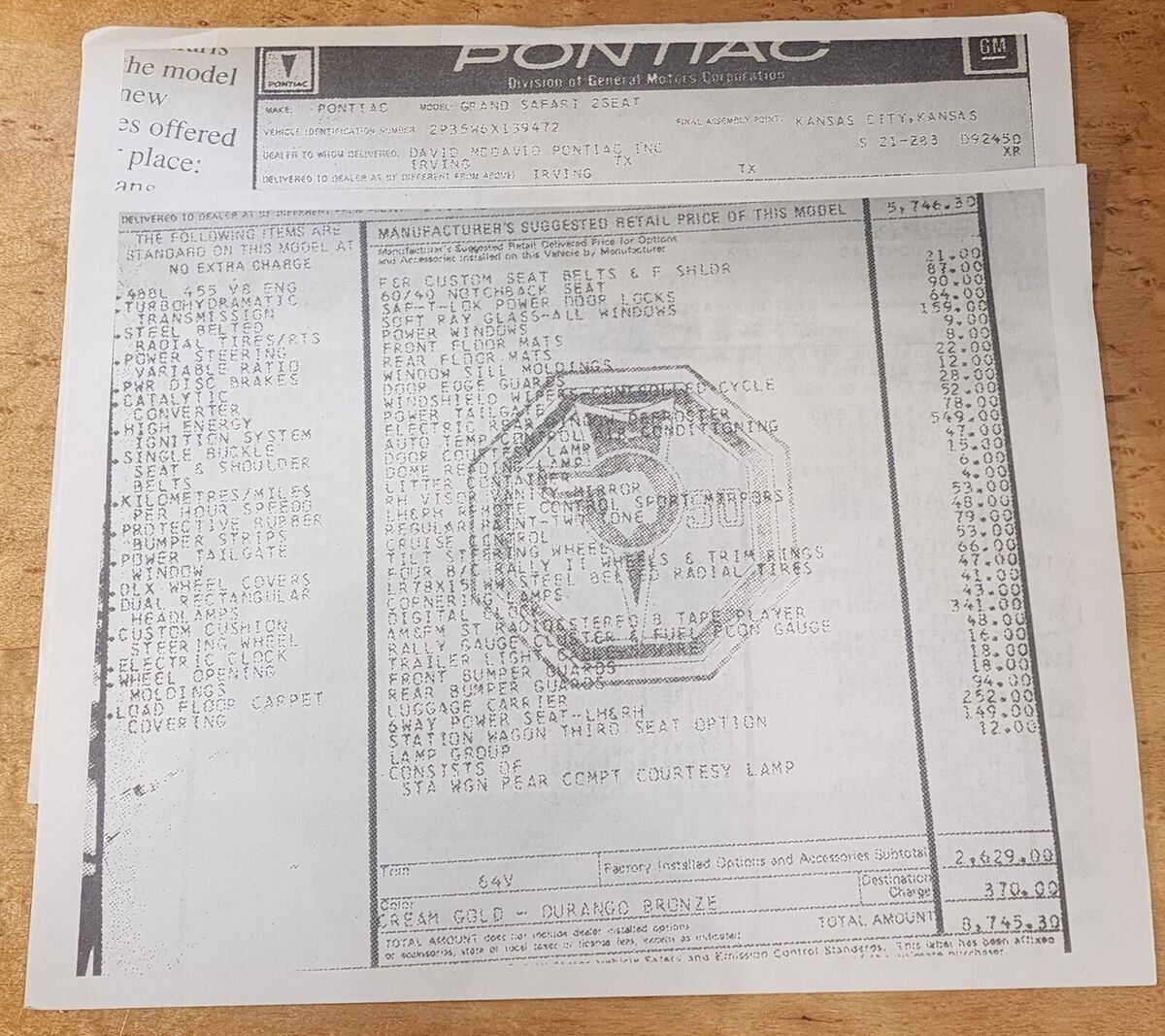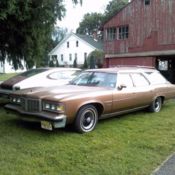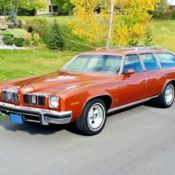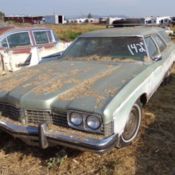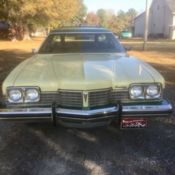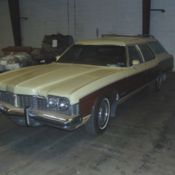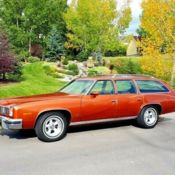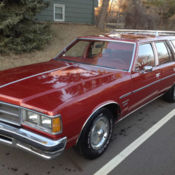1976 Grand Safari Station Wagon with Every Factory Option
1976 Pontiac Bonneville Top of the line.
I acquired this beautiful Durango Bronze over Cream Gold 2-tone fully loaded Grand Safari from my friend in September 2001, one year after he acquired it from the original owner with 121,000 documented miles. I contacted the original owner, George Parks, also a Dallas resident, and became telephone friends for the rest of his life. At the time that he gave the '76 Grand Safari to my friend Kevin, he retained ownership of his '73 Grand Safari and was happy that my intensions for the '76 were to maintain and preserve it, parked in my commercial building with my other collector cars.
As to flaws seen or not seen in the pictures, I will start with the right front fender. I recently was backing the car out of my residential garage and caught the right front fender wheel opening on the garage door frame, causing a slight dent at the top of the wheel opening. Additional new picture to be added.
I noticed that the right rear door obviously had been replaced, since I saw red paint on the inside (below the door panel) where yellow paint chipped off. After asking George about this, he recalled that when the car was 2 years old that his sister borrowed it and was hit in the right rear door which also explains body filler and fading gold paint on the roof just above the rear edge of the door frame. In the last 6 years, the paint on the right rear door and quarter has started to flake - obviously, from the 1978 collision repair. I tried to touch up, however, the custom mixed (according to paint code) paint did not match the sun faded paint on the car.
The right rear quarter is somewhat wavy due to backing into a cement filled steel post approximately 5 years ago. After popping the bumper back out on its shock absorber this was evident. However, the bumper urethane filler panels are supple and did not crack. The black rubber strip that is attached (the entire width) of the tailgate, by screws (that can be seen in the picture), long ago cracked. However, I have kept it for reproducing purposes. The rubber weather strips on either side of the rear window have begun to deteriorate and the rear window needs help to raise and lower. The electric tailgate operates perfectly.
Recently, a few of the roof rack screws pulled out of their anchors (in the roof). Note that the rear crossbar of the roof rack is bent downward and has been that way since acquiring the car.
I caused a slight crease just above the chrome rocker molding on the left rear quarter, behind the wheel.
Note, on the driver's side roof, above the rear door, the paint is bubbling. Moving to the front, the urethane bumper filler (full width) is still soft with no cracks, however, it slightly curves upward (in the center), which allows water to collect when washing the car. The bumper itself, however, will require re-plating even though I have consistently polished it.
Upon opening the driver's door, unfortunately, due to its first 25 years, only being parked under a carport, the padded dash is noticeably cracked due to the Texas sun. I have never been able to locate a replacement padded dash, even though that same dash was used on all B-bodied Pontiacs from 1975 - 1976. All 4 door panels, upper and lower, are in original condition.
I removed the 60/40 front seats 4 years ago and took them to my upholsterer to be recovered, only to be lost in a building that was foreclosed on due to Covid. I never could retrieve those seats, so I installed tan velour, 1976 Buick Park Avenue bucket seats and a Talisman console and the plush Park Avenue buckskin carpeting, front and rear. A nice look being factory GM and have not replaced with recovered GM 60/40 seats. The current seating and carpeting will be removed and the original carpeting reinstalled even though it has wear, consummate with age. I will acquire and install GM 60/40 seats, prior to the buyer taking possession of the car, preferably with the correct Pontiac upholstery pattern.
The second and third seats' Morrokide upholstery is in excellent original condition as well as the third seat carpeting. The rear interior panels located on either side of the third seat, including the spare tire cover's plastic is deteriorating, so it was my intention to have my upholsterer create French seamed vinyl covers like those found in the Custom Cruiser wagon. The same for the B-pillar trim, as it too is flaking. The rear load floor carpeting mostly deteriorated and missing. One of the stainless steel trim rails is bent and needs straightening.
The headliner is in nice condition except for a 3" cut in the right rear and one other cut (see picture).
As to the optional equipment; all power windows operate, however, the rear ones are slow. I have replaced the power lock solenoids, as needed, various times over the years, but I know that some are inoperative. The power seat mechanisms are original to the car and work perfectly. The intermittent/controlled cycle wipers operate properly. The auto temp control air conditioning works properly but is low on Freon again. The rear window defrost only partially works as the grid has two cuts that need repainted. The AM/FM 8 track 4 speaker system operates properly. Both cable remote sport mirrors operate properly and hold their adjustment since they have no broken cables. I have rebuilt the tilt column and works properly and is tight. The cruise control diaphragm needs replaced but worked well prior to the rubber braking. The speedometer/odometer work well however, the trip odometer does not. Even though Pontiac offered adjustable pedals from 1974 - 1976 on B-bodies, for whatever reason, they were not available on the wagons. However, I did acquire a set of adjustable pedals from a Bonneville years ago with intent to bolt them on to my Grand Safari. The option is like a dealer add-on and not welded into the cowl. The under-the-column lower dash panel for this option contained the slide lever that adjusted the pedals, which I also have in my possession.
Under the hood, all is original except for the master cylinder and the water pump, as I have rebuilt the original starter and high output alternator. The plastic fan shroud was broken and repaired prior to my ownership. The 455 and the turbohydramatic 400 work well, whether in 100 degree summer temperatures or subfreezing temperatures, with no transmission slippage ever. I have kept the engine oil and transmission fluid and filters changed on a regular basis or as needed. I never accelerate this 5400 lb. beauty more than mildly from a standstill. Occasionally, on the freeway, I will accelerate just hard enough to effect an automatic downshift and enjoy the throaty sound of the rebuilt quadrajet.
I have thoroughly enjoyed this fully loaded 1976 Grand Safari wagon as my parents traded in our 1965 Biscayne wagon for our first "clamshell", a 1971 Chevrolet Townsman 3 seat, manual tailgate and then replaced that with a 1976 Impala 2-seater, which I took my driver's test in. Since then, I have mostly owned 60's, 70's and 80's Cadillacs but when offered this Grand Safari twenty some years ago, I was thrilled to become the conservator of this Pontiac that had more options than most Cadillacs.
Over the years, I have learned about the special engineering of the clamshell wagons to accommodate a forward facing third seat. This entailed utilizing leaf springs instead of the coils used on all other B-bodies as well as the Fleetwood 75/commercial chassis rear differential, drum to drum, including the larger brake drums. Even though Chevrolet offered the 350 as its base engine (for wagons), the 400 turbohydramatic was the standard transmission, providing the clamshells with a nearly indestructible power train. The normally over-the-axle exhaust pipe had to be replumbed under the rear axle (on the right hand side) and then made a 90 degree turn to exit on the driver's side of the vehicle. The end of the tailpipe was even specially fitted with an ovaled end piece which is still original to this Grand Safari. Many tailpipes have been replaced with just a round pipe since the special end piece has not been available for years.
As a result of the nearly indestructible powertrain and the fact that the leaf springs would push (downward on the rear axle) as the demolition driver of a clamshell "backwards rammed" other competitors cars, the rear tires would not contact the upper inner fender wells and would keep moving. Most all other demolition derby competitors' heavy cars had coil springs which would collapse as the trunk folded downward, forcing the rear wheels up into the fender wells, which stopped their cars. So, even though hundreds of thousands of clamshells were sold between 1971 and 1976 they have all but disappeared as they still are the first choice for demolition derbies.
It was rare for a family station wagon to be ordered with the luxury options that this 1976 Pontiac Grand Safari was ordered with, since station wagons were considered a utilitarian vehicle. So, as conservator of this extremely rare automobile and unable, for personal reasons, to effect a proper restoration, I am offering it to the connoisseur who is looking for a rust free, fully loaded GlideAway tailgate station wagon.
J.D. Powers reflects current valuations for the 1976 Pontiac Grand Safari Station Wagon at this link:
https://www.jdpower.com/cars/1976/pontiac/grand-safari/4-door-station-wagon-3-seats
My "Buy It Now" price is a great value to the astute buyer as it is $13,720 less than the J.D. Powers valuation for the car.
- Make: Pontiac
- Model: Bonneville
- Type: Wagon
- Trim: Top of the line.
- Doors: 4
- Year: 1976
- Mileage: 165000
- VIN: 2P35W6X139472
- Color: Yellow
- Engine size: 455
- Number of cylinders: 8
- Fuel: Gasoline
- Transmission: Automatic
- Drive type: RWD
- Interior color: Tan
- Drive side: Left-Hand Drive
- Safety options: Back Seat Safety Belts
- Vehicle Title: Clean Want to buy? Contact seller!
